Engraving of Algerian Slave Market
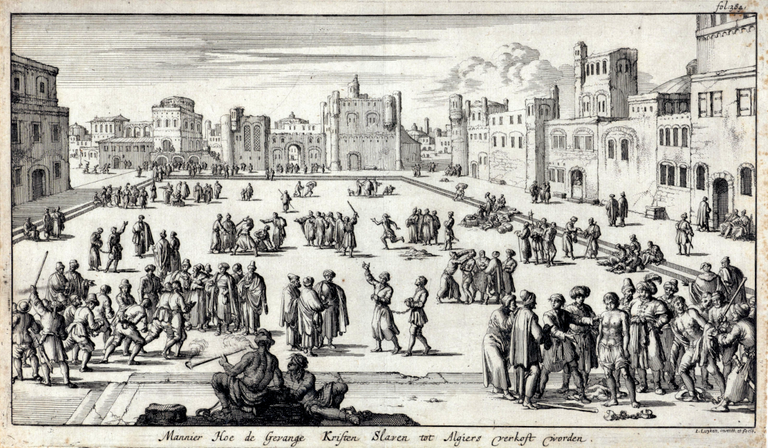
Credit. Jan Luykan (1649-1712). Engraving showing captive Christians being sold at market. 1684. Public domain
In summer of 1627 Barbary corsairs in four ships landed on the coast of Iceland, and sailed away with close to 400 captives. The Barbary raiders weren't looking for gold, or treasure. They were looking for people who could be sold as merchandise. This was the purpose of the raid: to capture humans, men women, children--even infants, and carry them back to Africa for sale. The trade in humans conducted by Barbary raiders lasted for centuries.
One of the people taken in the 1627 raid was Reverend Ólafur Egilsson. He recounts his experience in the book reviewed here, The Travels of Reverend Ólafur Egilsson, The Story of the Barbary Corsair Raid on Iceland of 1627.
Captain Croker, of the Royal British Navy Witnessing European Christians in Slavery, 1815
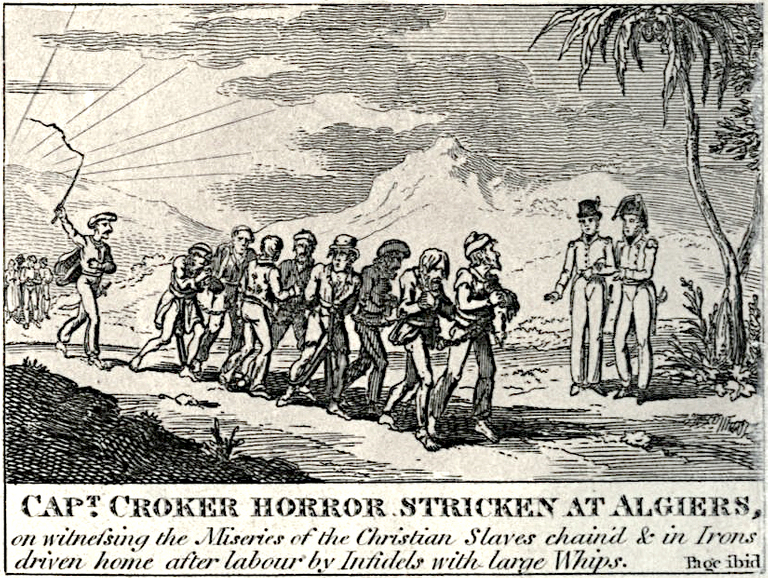
Walter Croker. Public domain. The caption under the original picture reads, " "Captain Croker horror stricken at Algiers, on witnessing the Miseries of the Christian Slaves chaind & in Irons driven home after labour by Infidels with large Whips". Credits include this statement: "London: printed for W. Hone, 55 Fleet-Street. 1816".
The fate of the captives varied greatly. The book by Reverend Egilsson gives a first-hand account that reflects the experience of one captive. Lest readers underestimate the gravity of the circumstance in which Barbary captives found themselves, the fate of the 400 Icelandic prisoners tells the sober tale.
Though the Reverend survived and made it back to Iceland, his wife did not gain her freedom for ten years. The Reverend himself was witness to the auction of his oldest child. The boy, eleven years old, was put on sale in an open slave market, sold off and never seen again by family or friends.
Reverend Egilsson describes the scene:
When we came to the marketplace, we were placed in a circle...Then the king chose from this group those whom he wanted...His first choice amongst the boys was my own poor son, eleven years old, whom I will never forget as long as I live because of the depth of his understanding
Priests Negotiating the Release of Christian Slaves Both the Reverend and his wife were fortunate. Of the 400 taken, only 27 eventually were returned to Iceland alive. These were redeemed by payment of a large ransom. The ransoming of Barbary slaves was sometimes managed by government, but often was achieved through private fund raising. Marquis Abraham Duquesne Frees French Captives, 1683 While I had learned about Barbary raids when I was in school, I never appreciated the scope of this banditry. One reliable source (Ohio State University), asserts that between the years of 1530 and 1780 as many as 1.2 million Europeans were captured and enslaved by Barbary raiders. I'm not sure why the last year considered in this count was 1780, because as late as 1904 Teddy Roosevelt, (U. S. President) sent a naval squadron to Morocco to free captured Americans. The U.K. France and Spain joined in the effort, also sending ships to Morocco. French Ships, "Kleber" and "Galilée", at Tangier Port, 1904 Often, European nations paid tribute to the rulers of Barbary Coast states to insure that their ships could sail the seas safely. Roosevelt ultimately went to war because he refused to pay tribute any more, and the Moroccan response had been to kidnap an American diplomat. I have read references about the Barbary corsairs that describe the capture and enslavement of Europeans as the 'white slave trade'. This is a mischaracterization of the corsairs' motives. They were out to capture Christians, whom they regarded as 'infidels'. This motivation explains why priests would show up to ransom slaves. If the priests suspected a slave had converted to Islam, they would not pay for that person's freedom. Likewise, if a Christian converted to Islam (credibly), then freedom might be granted by the captors. Map Purporting to Show Former Barbary States (Coastal Region) Rather than trading specifically in 'whites', the corsairs expanded their activities to include Sub-Saharan Africa. The number of people kidnapped from this area dwarfed by comparisaon the number of Europeans traded. Given the widespread nature of slavery among Barbary corsairs at the time, it seems remarkable the Reverend Egilsson would survive and would be able to tell of his experience. It is surmised that his captors let him go for two reasons: he was old, in his sixties, and not worth much on the market. Plus, if he made it back to Iceland, he could negotiate a good ransom price for the other prisoners. This is indeed what happened. He was let free, though given no resources with which to reach Iceland. His journey home was arduous and full of danger, but he did make it back in a year's time. After he arrived, he worked at negotiating freedom for his wife, his children (who never did make it back to Iceland), and surviving slaves. Galley of Sixteenth Century (Barbary Corsair Vessel) The Reverend describes his journey, and this tale is a fascinating window into seventeenth-century Europe. The narrative reads almost like a picaresque novel, except that this story is real, or as real as his memory allows. Egilsson met both kindness and cruelty along the way. He writes: I suffered great hardship and distress...I was reduced to drinking water that a lion, a bear and an ostrich, and some monkeys and poultry had drunk from and befouled. The family he left behind was in a wretched state. Many of the Icelanders had perished and his own family was suffering from illness. He describes the circumstances among the Icelandic captives at the time, as told to him by a 'Frenchman' he met: ...the man told me that many Icelandic people were lying sick and dying all around town...He also told me that in the Christian cemetery there were already thirty-one buried. As the Reverend travels through Europe we become aware of the circumstances that prevail on that continent. Every port at which he lands inspects him and others for disease. Plague is afoot and strict quarantines are in place across the continent. Also, the Reverend is at times turned away from one place or another because of his religion. The Thirty Years War is raging and he is told by a woman who is offering refuge to others that he should seek help from Luther. He is cautioned by another woman not to follow a certain road to Germany because everyone on that road is being slaughtered. Sack of Magdeburg,Thirty Years War, 1631 When reading this book, I was left with the thought that the chances of survival for anyone in that time were not very good. The Reverend and his wife were remarkable to have run the gauntlet of chance and come out alive. Although, they did lose all their children. If the slave trade carried on by the Barbary corsairs seems uniquely cruel, pull the lens of history back a bit to take in a view of others who raided European coastal communities. The Vikings plundered and ravaged populations all along the coast for centuries. According to history.com: the Vikings took thousands of men, women and children captive, and held or sold them as slaves...According to one estimate, slaves might have comprised as much as 10 percent of the population of Viking-era Scandinavia. Reports of the Viking slave trade include one Arab source that describes Viking's selling slaves across the Mediterranean, from Spain to Egypt. Viking Slave Chain It is even possible that Reverend Egilsson himself was the descendant of a Viking slave. Modern DNA evidence suggests the "fate of thousands of slaves – mostly women – who were taken by Norse Vikings from Ireland and Scotland before they put down roots on the North Atlantic island." There is of course the issue of hypocrisy when Europeans bemoan the fate of the brethren enslaved by the corsairs. At the time, the same European countries were carrying on the Transatlantic slave trade. This trade in slaves spanned the years of approximately 1526-1867, and resulted in the kidnap and enslavement of some 12.5 million human beings. Conclusion Title Page of the Book The Travels of Reverend Ólafur Egilsson This book was only translated into English a few years ago. It may be read free here, on archive.org. Or, it may be purchased in paperback or Kindle form on Amazon. The Reverend's narrative is not long, but the introduction and rich footnotes added by the translators adds almost as many pages as the narrative proper. I found it helpful to read another book, The Story of the Barbary Corsairs, by Stanley Lane-Poole published in 1890 and available on Project Gutenberg. This second book filled in the background for the events (historic and geopolitical context). However, if you just read the Reverend's book you will have a quite distinct experience. His description of the people, animals, boats and scenery of the different places he travels has the value of a first-person account. This is quite memorable on its own.
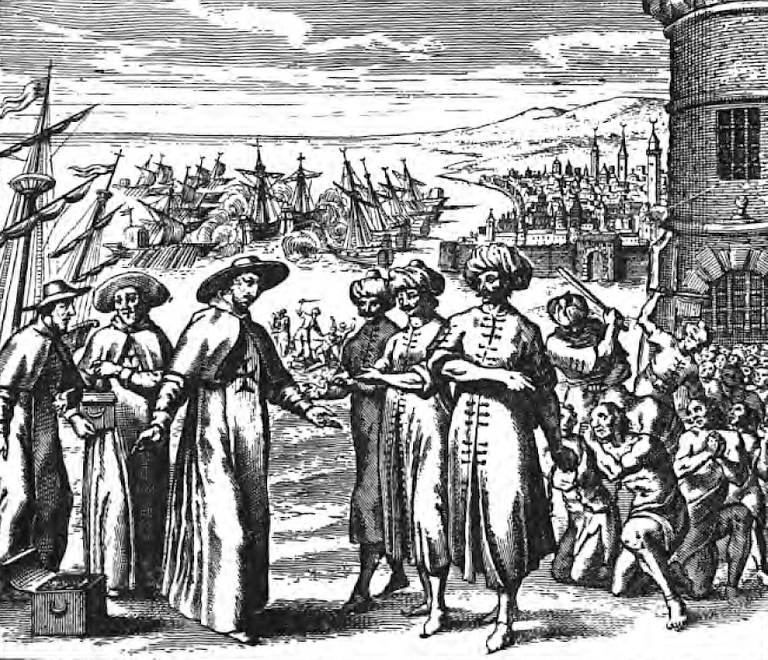
Pierre Dan, Histoire de Barbarie et de ses Corsaires. Public domain.
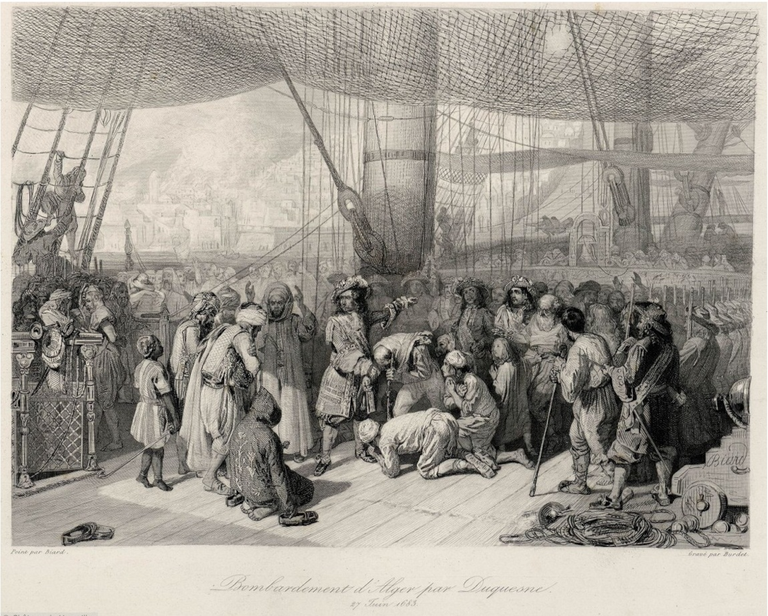
Credit: Girardet. 19th century. Public domain. The bombardment of Algiers...was a French naval operation against the Regency of Algiers during the French-Algerian War 1681–88. It led to the rescue of more than 100 French prisoners..." (From Profilbaru.com)
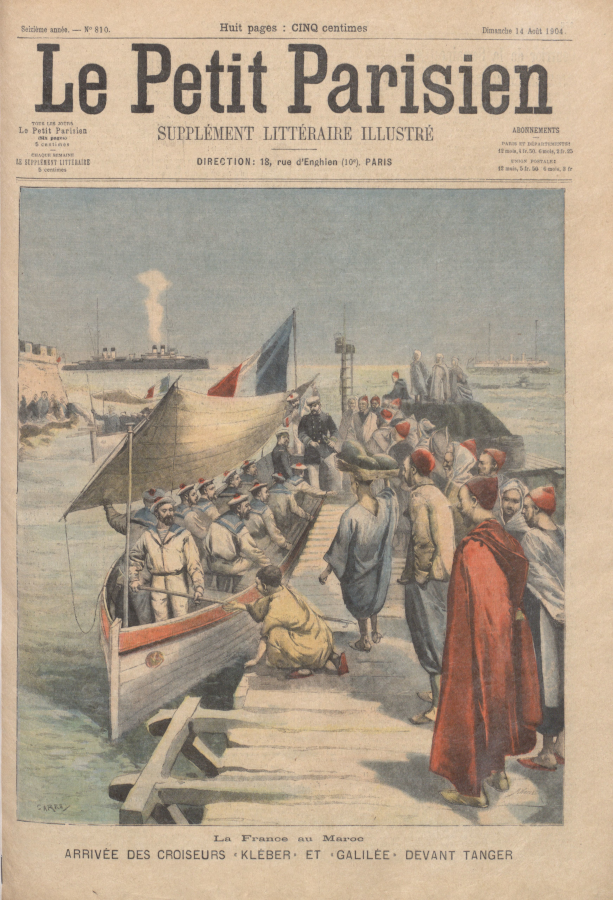
Credit: Le Petit Parisien. Public domain
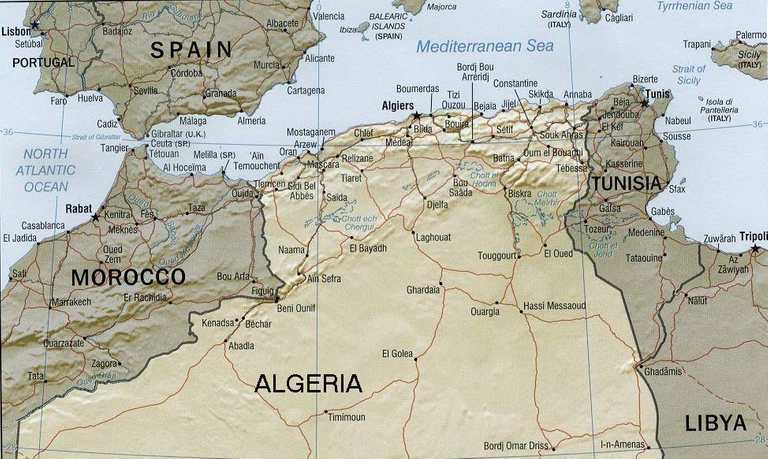
Credit: U. S. CIA. Public domain.
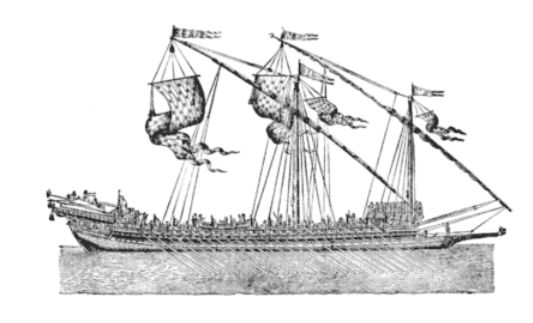
Credit:The Story of the Barbary Corsairs by Stanley Lane-Poole. Project Gutenberg. Public domain
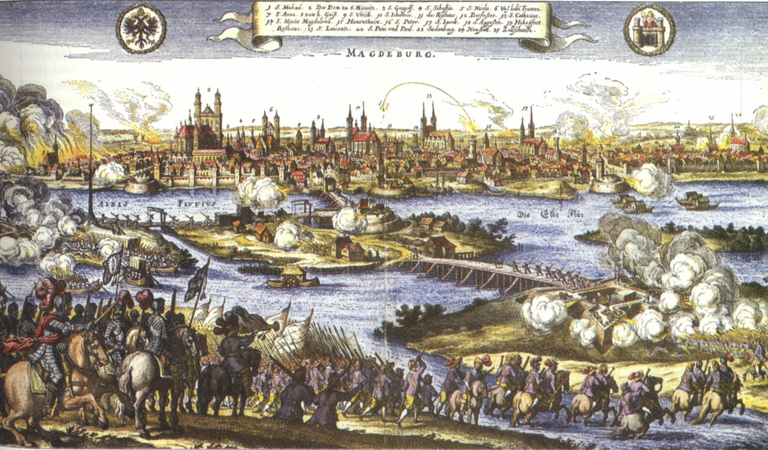
Credit: Matthäus Merian. Public domain. This German (Protestant) city was sacked by Swedish forces (Catholic). It is reported that 20,000 of the original 30,000 Magdeburg citizens perished as a result of the attack.
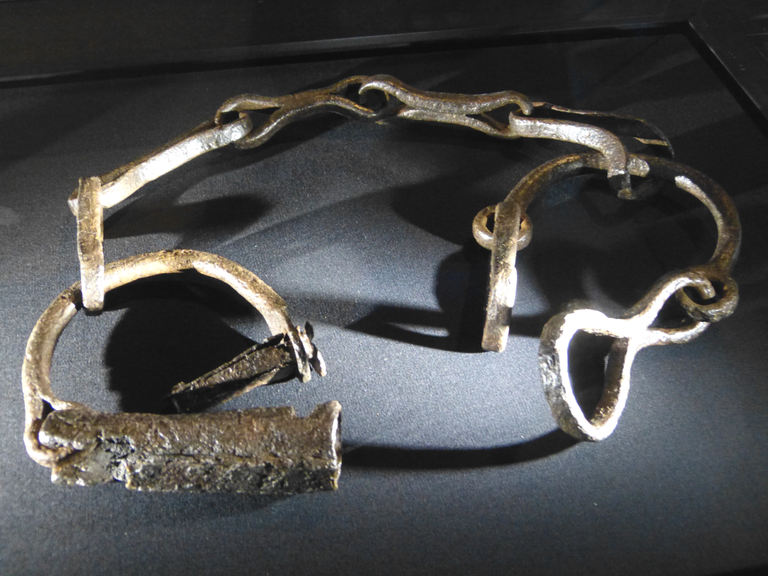
Credit:Wolfgang Sauber. Used under CC Attribution Share-Alike 4.0 International license.

Credit: Author Ólafur Egilsson, 1628. Public domain Translators Karl Smari Hreinsson and Adam Nichols

LIL GalleryCredit: @muelli. Public domain.
Many of the extended quotes cited came from:
archive.org
(https://ia803403.us.archive.org/22/items/the-travels-of-reverend-olafur-egilsson/The%20Travels%20of%20Reverend%20Olafur%20Egilsson.pdf)
Although I consulted many sources (referenced in my text) as I wrote this post, the most significant were:
https://www.gutenberg.org/files/22169/22169-h/22169-h.htm
https://www.greekrevolution.org/exhibition/monroes-empathy/fighting-barbary-pirates/
https://www.theatlantic.com/international/archive/2011/03/the-third-barbary-war/72749/
A GREAT subject. I'd heard about these raids before; didn't know there was a specific book dedicated to it.
All too often talk of 'slavery' only is about the trans-atlantic trade of Africans, which was big, to be sure, but the amount of Europeans that ended up in the Middle-East (through the Barbary States, as you point out) was very large as well.
Looking forward to more from you.
Thank you!The book was a find. As I looked up other sources on the Internet I found many that mischaracterized the trade (as I indicate in my blog) so, as is always the case, I had to check and double check my sources to keep the blog as true to fact as possible.
I think you and I may belong to a small club--people who find history, particularly primary-sourced history, fascinating. The challenge is always to bring the subject to life for readers who may think at first glance that the topic isn't interesting. :))
I really appreciate your great comment. I will surely catch up on your blog when I get back home later today.
Count me in, LOL:
One of my favorite history bloggers is Dublin journalist, editor, and novelist David Lawlor.
Picking just one post at random:
The Titans of Antarctica via @LawlorDavid
Splendid blogger - I should lure him over to Hive!
GREAT book review!! Thorough and compelling. The opening is as riveting as a novel.
Who knew: Iceland's badass Vikings - notorious raiders - got raided! Barbary ships land on the coast and capture humans, men women, children--even infants, and carry them back to Africa for sale. The trade in humans conducted by Barbary raiders lasted for centuries.
Thank you so much for an inspiring review. I had given up book reviewing. "Nobody reads my reviews anyway, except the authors themselves," it seemed. I know, I know, gotta tell myself a better narrative. I posted a few reviews (unpaid) at Newsblaze. Here at Hive, we at least get upvotes and feedback. Zero feedback from any Newsblaze review, so I just stopped...
But you have inpsired me!
And what a great topic!
And you inspire me, @carolkean. Years ago, when Hive went by another name, a very wise owl, (@mathowl) gave a piece of advice to a despairing blogger. It went something like this: write what you like and then at least you know one person will be happy. I'm really at the end of what career it was (of the many I followed) I pursued. No more pursuit. Read what I like. Write what I like. Of course, always have respect for my audience, otherwise just keep a journal 😅.
I'm very pleased my choice of subject and my treatment are to your liking. You are a professional, a discerning reader. Wow, it's nice to meet that standard.
Usually, when I write something like this, that might seem arcane to others, I run it past my husband when the blog is finished. He likes popular fiction. If his judgement is, 'That was interesting' then I've met the ultimate test.
Thanks for the feedback. I'll have to catch up on your blogs.
My standards are high, and you DO live up to them - you exceed them!
I love your blogs, and your interest in history is evident without ever being dull.
Why are so many h.s history teachers so dull? Why have so few been like you?
Love the advice from math owl!
Hi agmoore, the Egilsson book you show is a window into what Europe went through at that time, I can imagine all the frustration of seeing how she sold her children, all that stress and the terrible moments that will be recorded in that book.
Hello my friend, @innfauno12. When I read something like this it reminds me of all the suffering in the world, all the people who have suffered throughout history. It's a wonder we survive and go on. But then we do, every morning. We get up and meet the day. We see the sun and forget about the shadows.
Thanks so much for reading. I appreciate it.
I have not read a book before but the way you are telling me I will definitely read it and from what little I have read the post it is known that people in earlier times used to take money from their children and give them to other people.
Hello @djbravo,
Thank you for reading. I do recommend the book, and it is free on line so no barrier there. I read everything free if I can :)
Terrible things done to people, and that people do. One of the reasons I make collages is to forget about all that. Otherwise, it can make me quite sad.
I love your collages! In college, our son took up collage when he suffered a broken heart. Most of the images he chose were bright, happy, upbeat. Some fantastical (cloud walking).
This:
Terrible things done to people, and that people do. One of the reasons I make collages is to forget about all that. Otherwise, it can make me quite sad.
No wonder I love your work so much - visual and written. :)
Every day I must combat the tendency to feel sad for all the injustice and misfortune...
"Survivor's Guilt" keeps me from totally rejoicing over my own blessings.
(Yes, I'm working on that!!! Just, it's slow going.... others are hurting, and all too often, loved ones resist efforts to "help" - so we stand back and stop trying)....
I think the ability to look away is a survival mechanism. Sometimes it's hard (impossible), but we have to get through each day :)
So, I'm planning a collage about nature right now🐝
Most welcome dear. I will read it soon and i always like to learn things from others.
Hmm
I am always loving books like this and I will surely read this one in my leisure time...
Such a fantastic history!!!
P.S. Another thank you for the link to the book!
And this:
How does anyone ever get stuff done when there are so many good posts each day at Hive....?
I cannot begin to skim (much less READ +) even a fraction of them.
⭐️⭐️
This book is a true find.